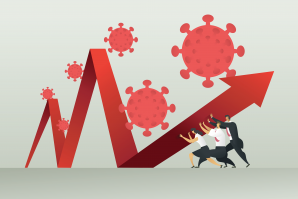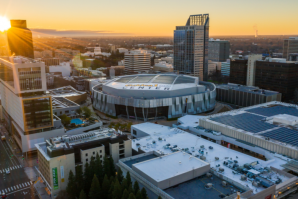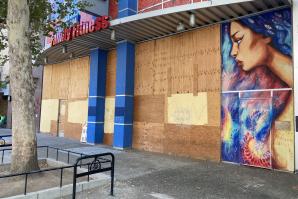Despite the supply chain disturbances, inflation and staffing challenges, most business leaders expect to do well in 2022, according to a national survey released this month by JPMorgan Chase. Among California and Arizona respondents to the 2022 Business Leaders Outlook survey, nearly 80 percent of small business owners say they are optimistic about their performance in the year to come. This may have something to do with worry burnout, or it may be due to a new level of flexibility that businesses developed in response to two years of crises. We spoke to Erik Langeland, market executive for Northern California and Northern Nevada at JPMorgan Chase Commercial Banking, about the results of the survey and how it reflects trends he sees working with small and midsize businesses in the Capital Region.
Do any trends stand out to you from the Business Leaders Outlook Survey?
Nine out of 10 business owners believe that their businesses will grow in 2022. That’s consistent when we’re talking with our client base. … It’s all about managing those growth numbers that people expect, whether it’s workforce challenges, logistical challenges, managing inflation or commodity prices. But all of those are challenges that can be overcome when you’ve got your end product demand. Most of our customers are saying we have the demand, we just have to figure out how to overcome some of those challenges. That’s a much better problem to have than not having the demand in the first place. That was the overall theme that I saw in the survey, and that is very consistent with when we’re out talking with business owners, what we hear from them as well in the local community.
“Most of our customers are saying we have the demand, we just have to figure out how to overcome some of those challenges. That’s a much better problem to have than not having the demand in the first place.”
What are some of the main growth trends that you see among those local business owners?
Our primary businesses here are in food and ag, government contractors, health care, real estate. Most of those businesses are finding lots of success just serving their existing clients, growing their market share and doing more with clients they’ve worked with in the past. We’re also seeing them expand geographically into new territories and really focusing on the top line. The demand is there for their products and services. It’s a matter of managing that growth.
What are some of the main challenges going against that growth, and how are businesses meeting those challenges?
The biggest headline is challenges related to workforce and attracting enough talent to meet the demand for their products and services. We hear that basically in every meeting we go to. … You’re definitely seeing wages go up, for sure. You’re seeing more flexible arrangements: work from home or flexible hours. And then you are of course seeing some tweaks to health benefits and 401k packages. The headline for sure, though, is that wages are going up.
Do you see those rising wages and benefits becoming a burden for any businesses?
Well, you certainly have to figure out how to manage through it. And I think business owners have been unbelievably resilient over the last two years with all the things that they have faced. So rising wages is, in some ways, a good problem to have, because it means that you have top-line revenue growth, and you’re trying to figure out how to get the products and services out the door. If you have to pay a little bit more for that workforce, as long as you have the revenue, it’s not a problem and can be managed through. We’re just seeing that to be the No. 1 challenge, but also, in some ways, it’s an opportunity as well.
What about supply chain challenges, another headline we’re hearing a lot about?
Absolutely, it is a challenge. Importing from Asia was a couple thousand dollars a unit a couple years ago, and now you’re talking about multiples of that. So trying to figure out how to get the product here, managed through those logistical challenges, and the rising costs are also challenges. But again, I think as long as you have the top-line revenue, growth and demand for your products and services … companies are adjusting their prices in order to offset those costs, for the most part.
Consumers are also increasingly demanding more environmental, social and government commitments on the part of businesses. How are business owners meeting those demands?
More and more, the consumer wants to spend their money with companies they know have goals aligned with their own and values aligned with their own. And so as a result, you’re seeing more and more companies outright publish an ESG summary of their goals, which allows the consumer to shop where they want. It’s just one more factor in the decision process for where to spend your dollars. More and more companies are embracing that, how to be as green as possible for their own businesses, for their societies, and to attract new customers.
How do you see businesses adapting to the uncertainty of the coming year?
“Since we don’t know exactly what will happen with the virus tomorrow, I think companies are prepared to figure out how to continue to run their business to meet customer demand.”
We’ve seen a blip in inflation, we’ve seen a blip in supply chain links, like we talked about. And the Fed just came out and said that it does believe that they are positioning for increasing interest rates to help stabilize the economy overall. Companies have learned a lot over the last two years on how to manage through unknown time periods. When you have a lack of visibility into the future, it can make it challenging to make business decisions. And I think companies learned how to adapt and change very quickly as information became available and the situation changed. I actually think that’s very good for our economy overall, and for individual businesses, to be able to pivot quickly as the situation changes. …
Since we don’t know exactly what will happen with the virus tomorrow, I think companies are prepared to figure out how to continue to run their business to meet customer demand. That means some of the things we talked about before: enabling employees to work from home or work flexible hours, focusing on new supply sources to better diversify their supply chain to make sure they have products available to sell. Just having that flexibility, I think, is the best thing that came out of the pandemic.
Edited for length and clarity.
Note: This article was updated to correct Erik Langeland’s job title.
–
Stay up to date on business in the Capital Region: Subscribe to the Comstock’s newsletter today.
Recommended For You

It’s Complicated
Business experts express optimism and concern over the Capital Region’s 2022 economic outlook
After a once-in-a-century pandemic, what happens next? The
Capital Region’s economic experts weigh in.

Powering Through the Pandemic
Local governments pull out all the stops to keep their economies rolling
Some solutions Capital Region governments have come up with
will stay around post-pandemic, which could further improve the
business climate.

Sports, Arts and Entertainment Reemerge in the Capital Region
The regional business of entertainment, arts and sports is reemerging with new structures and outlooks in place.

Can Downtown Sacramento Recover From COVID-19?
Downtown Sacramento has been hard hit by COVID-19, stalling its recovery from years of decay. Can it snap back?

The Next Act
Part 6 of our ongoing series on downtown Sacramento businesses dealing with COVID-19
Sacramento businesses continue to adapt and recalculate as COVID-19 evolves.

Holding Pattern
Variety of local businesses shuttered by COVID-19 await reopening
Comstock’s has been following four businesses that have been helping to drive the resurgence of Sacramento’s central city in recent years. Here’s how they’re faring a month into the shutdown.



